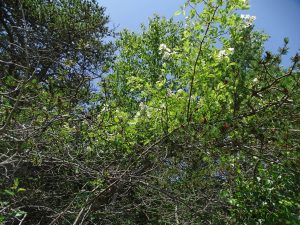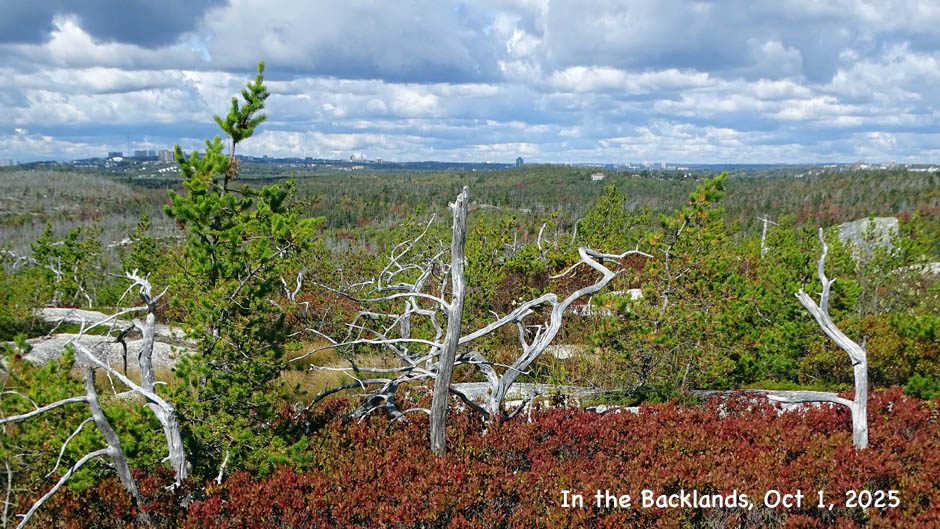By David Patriquin

Two stages in which R. multiflora is quite readily seen and identified in Halifax area – left when it is in flower, early July; right in winter when clusters red berries stand out (if not already consumed by birds)
Click on images for larger versions
It’s peak flowering time for Rosa multiflora, an invasive species that can be challenging to remove once it gets well established. The plants are readily spotted when they are flowering, so its a good time to be on the lookout for them, especially when they are just getting established and are most readily controlled.
To my knowledge, and from the records on an iNaturalist Project for multiflora rose (likely under-reported), it hasn’t yet gained a significant foothold in the undeveloped lands of the Backlands proper. However, it has been noted in a few spots** and it is socked into many areas along trails and roadsides in nearby areas, e.g. along much of Purcell’s Cove Road and in the area of Connaught Battery.
**iNaturalist records of R.multiflora within the Backlands are currently restricted to those shown in the maps below:

Records of R. multiflora within the Backlands July 6, a.m. Two of the infestations in the map at right were cut back by volunteers from WLCC. Update July 7 p.m. : Another record was added today, see below. Click on image for larger version.

Multiflora rose growing over Jack Pine at the edge of the open field at Connaught Batter Park, July 6, 2023
The key to keeping multiflora rose out of the undeveloped Backlands is to be vigilant and attack it early where it gets a bit of a foothold. That can involve completely removing the plant, roots and all – sometimes next to impossible without major disruption & use of a bobcat (machine, not the animal!) &/or ugh, glyphosate – or simply cutting it back every couple years to prevent flowering and seed production; such cutting back also weakens the plants, making them less competitive with native species. The Williams Lake Conservation Company folks have had some success in this regard, stopping its spread in the area of the parking lot for the Shaw Wilderness Park, and by the dam* on Williams Lake (Thx M.D.!)
* That was in 2021. Unfort it has come back ‘with a vengeance’ – observed on July 7, 2023, see https://www.inaturalist.org/observations/171931323
If you see multiflora rose anywhere in the undeveloped Backlands, as possible, please photograph it and upload the photo(s) to iNaturalist so it appears on the project map. It would be helpful as well, to upload photos (with locations) of plants observed within a few hundred meters of the undeveloped Backlands, so we can keep a special eye on those areas.
For more info, view:
– backlandscoalition.ca/Natural History/Flora and Fauna/Exotic & Invasive Plants
– backlandscoalition.ca/Natural History/Flora and Fauna/Exotic & Invasive Plants/Rosa multiflora
– Invasive & Exotic Plants are making their way into the Backlands 13Jun2021
– N.Y. Invasive Species Information: Multiflora Rose
Description of the species, its impacts and how to control it.
– Multiflora rose, an invasive that crept up on us in Halifax, NS
Post on sandlakebedford.ca, Aug 9, 2019
—————————————————————————————

Joshua Barss Donham photo July 6, 2023, from iNaturalist post. Inset shows location.
UPDATE, shortly after making this post, JBD posted a report on R multiflora in the Pine Island Ponds Area.
He noted: “At least two large ‘patches’ of multiflora rose climbing up surrounding trees/shrubs where a rough path crosses the outflow.”
